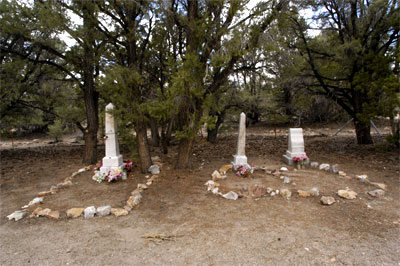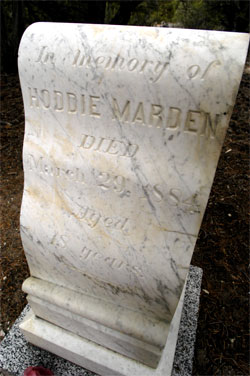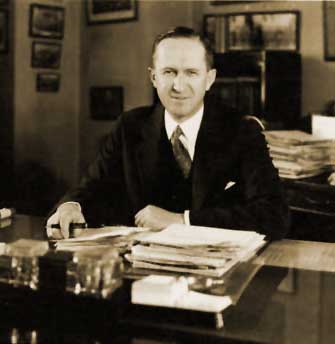|
A Nostalgic Visit to An Old
Cemetery
On a exploratory drive through the
mountains near the California-Nevada border one warm summer day, my
husband and I found ourselves near the site of the former town of
Aurora
. There was nothing left standing of the place that at one time was the
county seat of Mono County, California, except a couple concrete walls
that had sad and lonely looking window holes in them
On a
hill just out of the main part of the old town-site sits what remains
the only real proof of the existence of the town, the Aurora Cemetery.
Many graves are still visible and many of them have headstones still
readable, although a lot of the markers have fallen down, due to snow or
rain or just time. Fencing surrounds some of the graves, either wrought
iron, or woven wire or wood. Most are simply mounds of dirt surrounded
by native rocks, with no markers at all. The graves are located in
between pinyon trees, many of which were probably not even there when
the graves were dug. In some cases the roots of the trees are tilting
the headstones.
 |
| The Marden graves in the
Aurora, NV, cemetery (September 2004). |
Walking around the lonesome old place made one think of all the
folks lying there, their families and their stories. Most of the burials
took place in the early years, and before 1920. Some were clearly
single men, miners from some foreign land or from the east who had been
buried by their fellow miners. Some were families in groups with one
main surname and with the added names of in-laws, the husbands of the
daughters in the family. In several cases, just a young wife who had
died too young, perhaps during childbirth, or maybe of overwork in a
harsh and lonesome environment.
One
grave marker tells a sad tale of a young family torn apart by what must
have been an epidemic of some illness that took four children all under
the age of 10 and within ten days time. This was a tall four-sided
column, engraved on all four sides with their names and dates. They
were: "Dick, age 6 died Feb.16, 1878. Frank, 8years old died
Feb.20, 1878.
Pearl
, age 2,died
Feb. 23, 1878
, and Daisy 4 years old who had died on
Feb. 26, 1878
." The engraving also states that these are the children of Horace
and Lizzie Marden. As if the loss of those four children weren't
sad enough we found another, earlier, grave there for James, Eldest son
of H. and Lizzie Marden, "age 7years 8 months, died
March 9, 1865
." Then further on another marker engraved with the name
"Hodie Marden son of Horace and Lizzie Marden, died
March 29, 1884
age 18." Lord, there were six children of this same couple,
gone, and it was almost too much to bear. Did they have other children,
or were they now left alone?
 |
| Hoddie Marden's grave in the
Aurora, NV, cemetery (September 2004) |
I
just had to know more about these children and their family and
proceeded to search for the story of their lives. I was
lucky to find some data about the family and will use these
findings as well as my imagination to piece together what I believe
happened to this family.
Learning to Know The Marden Family
Horace Marden was born in
Maine
in 1832[i] and like thousands of others, Horace left for
California
during the gold rush. He crossed the Isthmus of Nicaragua and arrived in
California
before his twentieth birthday (1852). He wisely chose business
ventures other than actual mining to eke out a living. He started a
freighting business that he would eventually operate throughout the
mining country of
California
and
Nevada
for over forty years. He also built and operated stamp mills in Bodie
and Aurora. [ii]
He
and Lizzie married in 1856. She was born in
Mississippi
[iii]
in October of 1837 [iv] and was probably brought west by her parents who may also
have been bitten by the gold fever. Their first child, James, was born
in 1857. In June of 1860 son Esra was born [v].
Then later in the year of 1862, in Mokelumne Hill California Mary was
born. [vi] A little girl who was
named after her mother, Lizzie, was born in June, 1864 [vii]. After
her came Hodie, born in 1866. (I cant help but wonder if this child
wasn't named Horace after his father but was just called Hodie [viii]). After Hodie came
Frank in 1870 and Dick in 1872. Daisy came in 1874, and Pearl in 1876,
who were probably born in
Aurora
.
Horace traveled far and wide throughout the mining country and got
involved in other moneymaking businesses to help support his growing
family. The family evidently lived for some time in
Bridgeport
, or Big Meadows as it was known in the early days. I found references
to him in two books about the area that say the was in the lumber
business there [ix]
and another that states that Horace and partner D.O.Waltze built and
operated a toll road from Big Meadows to Castle Peak the location of the
Dunderberg Mine. [x] Since the mine did not do well the toll road was not a
successful business venture. But he still had the mills and the lumber
and freight business going for him.
The
family then most likely moved to
Aurora
where in February, 1878 a diphtheria epidemic came through and took the
four little ones whose grave we saw in the
Aurora
cemetery. I think that the gravestone we saw for James who died in 1865
must have just been a memorial to him, unless his body was exhumed from
a cemetery in another location and reburied at
Aurora
. While still living in Aurora, Horace Marden also had served a term or
two in the
Nevada
legislature. [xi]
The
census taken in June, 1900, found Horace at age 68, and Lizzie, age 62,
living in the home of their son Esra and his wife Sadie, and their
daughter also named Sadie. This was in the town of
Edgewood
in
Siskiyou County
,
California
, which is in the far north of the state close to the
Oregon
border.
Edgewood
is located in the
Shasta
Valley
at the edge of the forest, hence its name. The occupations of both
Horace and Esra was listed as "contractor-loggers."
Meanwhile the two surviving girls, Lizzie and Mary, were growing up and
getting on with lives of their own. Lizzie married Wils (Wilson) Yandell
[xii]. They eventually had
three daughters. In later years, Wils became county assessor and postmaster
and Lizzie became a photographer. [xiii]
Mary, unlike most women of the day, attended college in
Napa
. She later married George Albright. He was a Canadian immigrant who had
apprenticed to a cabinetmaker and was very good at that trade as well as
general carpentry. He used these talents in many of the mining towns. He
became a millwright and engineer at the Northern Belle Silver Mine in
Candelaria
,
Nevada
[xiv].
When the time came for the birth of her second child, in January, 1890,
Mary chose to go to Bishop, California for the delivery as she had lost
her first baby at birth in Candelaria just the year before. [xv]
Mary named her baby boy Horace Marden Albright in honor of her father.
Soon afterward the family moved to Bishop permanently as the mines were
playing out and the price of silver was declining. [xvi] Mary and George had two other sons, Leslie and Dewey.
Granddad Horace enjoyed taking young Horace, and later his brothers,
camping with him in the mountains surrounding Bishop. He taught them to
enjoy and treasure the outdoors. In later years when young Horace was
old enough, he took summer jobs in his Granddad's logging camps, where
he taught him about his feelings on the stripping of the forests for
lumber and his frustration that nothing could be done about it [xvii].
Horace Albright went on to graduate from the
University
of
California
, and the
Georgetown
University
Law
School
. He became the Assistant to the U. S. Secretary of the Interior,
Co-founder of the U.S. National Park Service, the first Superintendent
of Yellowstone National Park etc. etc. plus receiving many awards.
 |
| Horace Marden Albright (National
Park Service photo). |
Horace Marden died in San Francisco of a heart attack on December 30,
1916 just shortly after hearing of his grandson's success in creating
the National Park Service.
I'm
sure his aunts and uncles, whose young bodies were buried in that
lonesome cemetery on the hilltop at what used to be the town of
Aurora
,
Nevada
, were looking down on their family all the while. I'm sure they were
proud of them all but especially of young Horace Marden Albright, who
learned the value of preserving and enjoying the great outdoors from his
granddad, their father, Horace Marden.
A
Few Random Notes About Horace Marden and George L Albright
Will A.
Chalfant, editor of the Inyo
Independent newspaper, and author of several books wrote in his book
Gold, Guns, & Ghost Towns in his chapter on Aurora on p.78,
telling about the high grading that went on in Aurora. This was a polite
name for stealing or practice of miners to conceal a little ore in their
lunch buckets or pockets when they quit work for the day. He wrote,
"A number of small plants for handling stolen ore existed. One
foundry man put in a little mill to work such ore as miners would bring
him.
There being no system of assaying, buyers would spit on the
sample, wrote Horace Marden, Aurora pioneer, rub it, look wise and name
their own price Under such loose conditions it was quite easy for miners
who submitted ore legitimately taken from their own mines to deceive
themselves as to its value. In consequence, the mill man had to stand
many accusations of unfairness, however honestly (according to their
best standards of judgment) they might deal. Mr. Marden wrote that if he
had all the bullion he had been accused of stealing he could have
left camp with a competency."
(I
had to look that word up in the dictionary. Here's what it said: competency: Property, or means of subsistence sufficient to furnish the
necessaries and conveniences of life without superfluity. I
guess so, Horace.
*
* * * *
In the same chapter of his book, Will
Chalfant relates a story told by George L. Albright, (Horace Marden's
son-in-law) whom he described as a timber man. In a mine named the Del
Monte, a shaft of 1000 feet was planned. Water came into the shaft at
500 feet so copiously that the largest pump obtainable on the coast was
installed to handle it. Unprofitable work went on for a couple years
when the depth reached was 800 feet. The inflow increased beyond the
pump's capacity, and the foreman and others went down to see what was to
be done. The engineer, lowering the cage carefully, at once saw that
something was wrong, and hauled up the cage in time to save its
passengers from a watery death. George Albright, who was in that
cage, related that they stopped the cage at the next level and took out
miners and what machinery and tools they could before the rise of the
water compelled them to move on. George said that a car that was left at
the last level at which the cage stopped is still in the mine, with 500
feet of water between it and the surface.
*
* * * *
Ella Cain wrote in her book, The
Story of Early Mono Count, "
Aurora
had its bad men and its good men. Stories are written, and will always be
written, about the gunmen and the desperados of the early West, while
the name of the good sink into oblivion. Among the later I beg to
chronicle a few of the outstanding names among the thousands of good law
abiding citizens who lived in
Aurora
." She then goes on to name nine men, the second and fourth
were: Horace Marden, a pioneer who was prominent in the lumber business
in Big Meadows (Bridgeport), and George L. Albright, whose family name
is still prominent in Inyo county and Mono County
*
* * * *
Horace Albright, in his book, Creating
the National Park Service, wrote about an interview with a worker in
the National Park System. He wrote, "Although he spoke quietly he
not only used all the swear words I had ever heard, but he cooked up
some of his own --- Actually he sounded a lot like my old grandfather,
who proclaimed that it was all right to swear profusely and graphically
because the English language was so darn inexpressive."
*
* * * *
I have lost track of the exact page and quote in Horace Albright's book
where he credits his grandfather, Horace Marden, for his own
qualifications for his position in the National Park System. It went
something like this, "My granddad instilled in me a great love and
appreciation for nature and the great outdoors, and an understanding
that this all had to be preserved for future generations to enjoy."
*
* * * *
In her book, A Sagebrush Heritage,
Lorena Edwards Meadows tells about George Albright and family who lived
in Candelaria. George, aside from working as a mine engineer for the
Northern Belle, had a side business with a partner, Chris Zabriski, who
was also the Wells Fargo agent in town. They called themselves Albright
and Zabriski- A to Z. We get them all. You kick the bucket and well do
the rest. It was an undertaking business in which George used his
cabinet making skills to build coffins. Horace Albright also makes note
of that in his book.
*
* * * *
In the spring of 1876 Horace Marden along with the brothers, John
and Tom Parr went to Bodie to refit and put back in operation the
16 stamp mill of the defunct Empire Gold and Silver Mining Company that
had been bought out by Warren Rose and H. M. Yerington This fact
was told by Warren Loose in his book, Bodie
Bonanza. Loose' father was at Bodie then and knew these men
*
* * * *
FOOTNOTES
[i] From p.6
Horace Marden Albrights book, Creating
the National Parks Service
[ii] ibid
[iii] In the 1910 census for
Bishop, Inyo Co. CA Mary Marden Albright states that her mother was born
in Mississippi
[iv] 1900 census of Siskiyou
Co. CA Lizzie gives this birth month and year.
[v] Information from 1900
census Siskiyou Co. CA
[vi] H. M. Albright's book
p.4
[vii] Lizzie's name and birth
year found in the 1900 census of Bishop, Inyo Co. CA
[viii] In the 1880
census taken in Aurora Hodie is shown as "Horrace."
[ix] Ella M. Cain, The
Story of Early Mono County, p. 142
[x] Mono Diggings, by Frank S. Werdertz, p. 67
[xi] H. M. Albright's book
p.7
[xii] He was identified
from a family photo on p.153 of H. M. Albright's book.
[xiii] This information
from the 1900 census of Inyo County California.
[xiv] H.M. Albright's
book p.3
[xv] ibid
[xvi] ibid
[xvii] ibid
Thanks to Cecile Vargo for sending me the information about H. M.
Albright's book.
|

